|
FAQs about Marine Shrimp
Identification
Related FAQs:
Shrimp
Identification 1, Shrimp Identification 2,
Shrimp Identification 3,
Shrimp Identification
4,
Related FAQs:
Marine Shrimps
1, Shrimp Selection, Shrimp Behavior, Shrimp Compatibility, Shrimp Systems, Shrimp Feeding, Shrimp Reproduction, Shrimp Disease, Cleaner
Shrimp, Banded Coral
Shrimp, Dancing Shrimp,
Harlequin Shrimp, Pistol Shrimp, Saron Shrimp, Mantis
Shrimp, Anemone
Eating Shrimp, and More FAQs on
Marine Shrimp, Crustacean Identification, Crustacean Selection, Crustacean Behavior, Crustacean Compatibility, Crustacean Systems, Crustacean Feeding, Crustacean Disease, Crustacean Reproduction,
Related Articles: Shrimp,
A Few Common Shrimps for the Marine Aquarium by James W.
Fatherree,
|
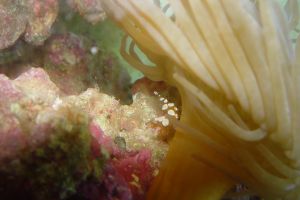
I believe in miracles.... where you from?
You sexy shrimp!
|
|
Query - I need help ID'ing something please
7/5/10
Dear all,
<Jackie>
My family and are just starting to set up our first Marine tank.
Your site has been really useful so far helping me ID some hitch
hiking starfish that came with our live rock.
We put the rock in 2 days ago and as I say we had about 5
Asterina on it, but last night we noticed the guy in the picture
attached. We're really new to all this so please excuse me if
I get the terminology wrong. He looks like a shrimp (to my
untrained eye) and is just under an inch long has pincers on his
front legs and is greenish in color. To be honest he looks like
he may have been hurt on the way from where-ever he came
from.
He was eating off the rocks last night though.
I just want to check to see if you had any ideas what he could
be?
<Looks like it could be a species of Tozeuma... a Hippolytid
shrimp:
http://wetwebmedia.com/hippolytidae.htm
at the bottom, and click on the link to the genus there>
We haven't got any inverts or fish in the tank at the moment
as we are setting up and I want to make sure he isn't going
to eat anything else that we do eventually put in there, so if
you could advise about this I'd really appreciate it.
Thanks in advance for your time and I hope that you can help. If
you need any more info please let me know.
Jackie
<Bob Fenner>
|
/Tozeuma/creature[1]%20Tozeuma.jpg) |
|
Shrimp ID: Likely Family: Palaemonidae --
5/3/10
<Hello, Lynn here today.>
Found this shrimp is a tide pool of the Gulf of Mexico near
Tampa. Looks to be some type of coral or anemone shrimp it is
female with eggs and it also has two pincer-like arms kind of
like a coral banded shrimp. Any ideas?
<It looks like something in the family Palaemonidae, a huge
group of shrimps that includes many transparent and
near-transparent species. Unfortunately, I'd need detailed
photos showing the rostrum (the beak-like projection at the
head), as well as the legs and various antennae/antennules in
order to confirm the ID even to family level. Identifying to
genus level would require even more detail. Please see the
following links for more information and photos for
comparison:
Grass shrimp in general:
http://www.dnr.sc.gov/cwcs/pdf/grassshrimp.pdf
Palaemonetes vulgaris (commonly sold as "Common Shore
Shrimp" to marine hobbyists):
http://www.mariculturetechnology.com/images/SWShrimp.jpg
Palaemonetes pugio females with eggs: http://www.ucs.louisiana.edu/~rtb6933/shrimp/Phero.html
Family Palaemonidae: http://www.wetwebmedia.com/palemonidae.htm
Take care, Lynn Z>
|
/2010-05-02_21.41.07[2]%20shrimp%20id.jpg) |
|
Strange Creature In Reef Tank...What Is It?
1/21/10
I found a weird creature in my fish tank last night when I was
feeding the fish and corals. This thing measures about 1'
long, it is like a transparent dark brown/green color similar to
a bait shrimp, the head is like in a flat arrow shape, it has
claws that was using to move the crushed seashells from under the
rock, it has pretty long antennas for his size, I'll say
about 1cm, it moves very fast, it will start crawling out very
slow to try to reach some food pellets but I never got to see the
full body out, I saw most of it but never got completely out of
the rock. I used to have an Engineer Goby that dies and I thought
it was a baby but now, this has a mixed look like a
lobster+shrimp+cockroach <?xml:namespace prefix = o ns =
"urn:schemas-microsoft-com:office:office" />
<??>
I managed to take some pictures (attached) but they came a little
blurry and I was only able to get the head , I circled in the
image the creature so you can see it. It moves very fast when
goes back inside the rocks so it took me about 10 minutes to take
the picture.
What is this thing?
<Well, as you say, the pictures aren't resolved enough for
an accurate ID, but by your description, I'm guessing you
likely have a shrimp of some type, possibly a Pistol Shrimp or
Mantis Shrimp. Are you hearing any clicking/snapping
sounds?>
Thank you.
<You're welcome. James (Salty Dog)>
|
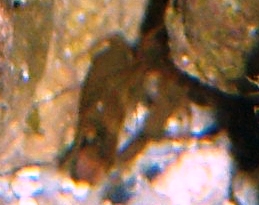 an Alpheid an Alpheid |
Re Strange Creature In Reef
Tank...What Is It? 1/21/10
Yes, I do hear some clicking sounds sometimes
<Then you likely have a Pistol Shrimp of some type, but not to
rule out a Mantis Shrimp.
You may want to trap and photograph, and send a couple of pics to
us or ID yourself by Googling. Traps for this purpose are rather
inexpensive and can be had on-line. If it is a Mantis Shrimp,
trouble lies down the road as it grows. For more info on both, read
here.
http://www.wetwebmedia.com/marine/inverts/arthropoda/stomatopods/mantisshrimp.htm
http://www.wetwebmedia.com/pistolshrimps.htm
James (Salty Dog)> |
|
Re: Gulf Coast Shrimp ID 7/2/09
Bobster..
<Super Lynn>
Just wanted to let you know that the shrimp query in my folder
may take a couple of days before it's answered. The little
fellows in question were caught in Port Aransas, TX, which is one
of my old stomping grounds.
<Neat... nothin' like a home-grown dirty shreemp
dish>
Luckily, UT has a Marine Science Institute there, so I've
emailed one of the faculty members to see if he could help.
The shrimp looks like a Hippolytid of some sort to me (akin to
what people call a Candycane shrimp - Parhippolyte sp?) but I
can't see enough detail to commit with any degree of
certainty and I'm not even sure if that genus' range
includes the Texas gulf coast. Anyway, if all goes well,
we'll have an answer in the next day or two, but with the
holidays (and probably a busy academic life!) who knows? If I
haven't heard anything by Friday night, I'll go ahead and
respond. If I hear anything afterwards, we can always add a
follow-up. Sound okay?
<Yep>
More than anything, I'm just curious as to what those little
guys are! I never saw them growing up or when I was there last
year - and you know I looked!
Take care,
-Lynn
<Will do. B>
Shrimp ID 7/2/09
Bob,
We have a dilemma trying to ID a shrimp we caught at the jetties
where we will be collecting. Lynn from WWM has joined our forums
trying to help us with the ID. I have included an attached
picture of the shrimp. Here is a link to our forums, if you care
to join in our discussions. Please register with a Username and
when you do, we would like to offer you a Complimentary Charter
Membership.
<Thank you Steve... The closest thing I can find to fit the
animals in this image is Lysmata seticaudata... How did it get to
the Gulf of Mexico from... the Mediterranean? Got me!
BobF>
Link: http://maast.org/forums/showthread.php?t=52235
MAAST President
TMAC 2010...in the works
|
/Lysmata/Steve's%20shrimp.jpg) |
|
Gulf Coast Shrimp ID --
7/4/09
<Hello there, Lynn here today>
Can you ID these shrimp caught off the gulf coast at the Port
Aransas jetties?
<They look like some sort of Hippolytid (Family Hippolytidae -
cleaner, peppermint, etc. shrimps,). The closest in color/general
appearance that I've found so far are several species listed
as belonging in the genus Parhippolyte, such as P. misticia, but
appearances can be deceiving. When it comes to ID's, details
are everything. You'd need to be able to get in close and
compare various features, for instance rostrum length/shape, and
compare them to either a good diagnostic/identification key or
known species within the various Hippolytid genera. Luckily,
I've got a link to a terrific key covering various shrimps,
including those in the family Hippolytidae. Start on page 59 for
a key to the various genera:
http://www.sil.si.edu/smithsoniancontributions/Zoology/pdf_hi/SCTZ-0587.pdf
I've also contacted a faculty member at the University of
Texas Marine Science Institute there in Port A to see if he could
lend us a hand. I received a message from him stating that he was
going to look into the matter for us and I very much appreciate
it! I will certainly keep you informed regarding any results or
developments that come my way. By the way, here's a link with
a photo of Parhippolyte misticia:
http://www.flmnh.ufl.edu/reefs/guamimg/crustacea/caridea/Pages/Image17.html
More re: family Hippolytidae -
http://www.wetwebmedia.com/hippolytidae.htm
>
Thanks..
<You're very welcome! Take care, LynnZ>
Hi Bob and Steve...(see message below in <<...
>>)
<Thank you Lynn! BobF>
<<Always a pleasure, Bob! - Lynn>
Re: Shrimp ID
Bob,
We have a dilemma trying to ID a shrimp we caught at the jetties
where we will be collecting. Lynn from WWM has joined our forums
trying to help us with the ID. I have included an attached
picture of the shrimp. Here is a link to our forums, if you care
to join in our discussions. Please register with a Username and
when you do, we would like to offer you a Complimentary Charter
Membership.
<Thank you Steve... The closest thing I can find to fit the
animals in this image is Lysmata seticaudata... How did it get to
the Gulf of Mexico from... the Mediterranean? Got me!
BobF>
Link: http://maast.org/forums/showthread.php?t=52235
<<Yep, the closest I've gotten is Parhippolyte
misticia. Unfortunately, I haven't found any info regarding
their range include the Texas coast. Here's a link w/photo:
http://www.flmnh.ufl.edu/reefs/guamimg/crustacea/caridea/Pages/Image17.html
The good news is that I did hear from Dr. Munguia yesterday
morning. He's going to look into the matter for us - Yay!
Until then...y'all take care and have a great fourth!
Lynn>>
|
Live Rock Exchange and Shrimp ID
12/12/08 Hi Crew, <<Hello unsigned query writer>>
I have a 10 gallon that has been successful in 5 out of six years.
<<A difficult volume of water to maintain>> Year one was
prior to knowing about WWM. <<Ah!>> There was a recent
answer to someone to think about replacing older live rock.
<<Yes? Bob does suggest this on about an annual basis, for
reasons of a fresh injection of bio-mineral content and to refresh
biodiversity>> So I guess that would go for me as well?
<<Goes for anyone utilizing live rock, yes>> I originally
got uncured live sent to me (25 pounds) and it was an interesting
experience. <<Indeed?>> My LFS always has rock curing but I
was wondering if I will still get the biodiversity that I would like
from that rock versus curing my own. <<Depends on their curing
method and how long the rock has been sitting around I think. But it is
my belief that receiving fresh rock directly from a collector and
carefully curing it yourself will result in the highest survival of
biota versus having the rock shipped and handled (or mishandled)
multiple times. And for swapping a small amount, you may find that
curing is not even necessary>> His rock is nice and clean so what
are my chances of getting some surprises? <<Pretty good really...
Most dealers keep their rock piled in unlit tanks/vats. Placing the
rock in a lighted, chemically balanced, and mature system will usually
result in the emergence of previously sequestered organisms (and some
not always welcome), assuming your livestock (i.e. hermit crabs,
shrimp, some fishes) doesn't consume the emergent life before you
notice it>> On a different note. As a kid I once bought those
dwarf seahorses sold on the back of comics. <<Ah yes, I too
remember those. Though my recollection of them was usually as a dried
up carcass. Unfortunately the little bit of provided salt added to some
tap water in a goldfish bowl was NOT sufficient to keep them alive as
many a child/parent was to learn>> So when I saw someone selling
them from the Florida Keys I decided to try it again which is how I got
into this six years ago. <<I see>> Anyway, included in the
stuff I got was supposed to be a peppermint shrimp. <<Mmm? I
wouldn't expect any Atlantic species of shrimp or crab to be good
tankmates for these seahorses. Too predatory?>> I was too new to
the hobby to know if it really was or not but lately I have been
wandering what it really was. <<I take it that it didn't
survive then?>> Its behavior was very different from other
shrimps that I have had since then. It had eyes on a short stalk, and
when the lights came on it would hide by burying its body in the sand
with only its eyes above the sand. It would stay like that until the
lights went out and then it would come out. Any peppermints I have had
seem to like to hang upside down in a cave or overhang. <<Indeed?
The burying behavior you describe is much like that of some species of
what we consider as edible shrimp. Being from the Atlantic (and
misidentified as a Peppermint Shrimp), this may have been a Pink Shrimp
(Farfantepenaeus duorarum)>> Thanks <<Happy to share.
EricR>>
Shrimp ID: Need more information
11/11/08 Hi, <Hi Andy> I have what I think is a shrimp
that lives in a hole in the rock. <Neat> It is black with two
arms with two thin long fingers which it hangs in the flow to catch
food. <Hmmm, do the arms just wave about (maybe they're
antennae), or are they actively picking at, or grasping things? Can you
see any small claws on the tips? Pistol shrimps have surprisingly long,
thin, clawed appendages for grasping food. Have you heard any clicking
or popping sounds emanating from the tank?> Its eyes are on swivels
looking in different directions looking for food. <Neat. That sounds
like a Stomatopod, or Mantis shrimp. They have extraordinary eyesight
made even better by the fact that their eyes are on mobile stalks.
What's neat about the stalks is that they can move independently of
each other which allows for an incredible visual range.> It never
comes completely out of the rock as it is growing, and it is slowly
making the hole bigger. It has been in the tank for about a year now.
It is not growing fast and is about 15 mm long. I have searched the web
and cannot find what it is. Can you help? <I sure wish I could.
Unfortunately, the best I can do without a photo is to refer you to
some sites for comparison so that you can hopefully narrow things down.
Please see the following links (as well as the associated links at the
top of each WWM page):
http://www.wetwebmedia.com/marine/inverts/arthropoda/shrimp/shrimp.htm
http://www.wetwebmedia.com/marine/inverts/arthropoda/stomatopods/mantisshrimp.htm
The next link has a terrific photo of a Pistol Shrimp's grasping
appendage that I mentioned above. Please see the fifth row of photos
under the heading Pistol Shrimp, on the far left:
http://www.chucksaddiction.com/hitchshrimp.html Andy <Good luck.
Take care, Lynn>
| Shrimp ID - Lysmata - 08/28/08 Hi! My
name's Andrew and I've been an avid reefer for 3 years =)
In that time, you guys have helped me tremendously, and I have
pointed friends to your site and we were all very pleased with the
vast amount of accurate information you have on your site. At my
LFS a friend and I came across two shrimp that we've never seen
before. The store said they have never had them either and this was
the first time they saw them on their suppliers list so they picked
two up. I know impulse buying without research is generally not
advised, but this is a shrimp and it's going in a nano tank
that has very limited inhabitants. The shrimp was labeled as a
Striatus Shrimp. However, when I look this up online I find the
common name is the Striped Hinge Beak Shrimp, and the pictures
don't look like what I have. <The common common name
problems.> The striped hinge beak shrimp looks very close to a
peppermint shrimp, however my "Striatus" is very
different. It is the same size as an adult Skunk Cleaner. However,
it does not have the white stripe cleaners have, and instead of
being red he is very pink...almost fluorescent or neon like. At
night time/early mornings the pink becomes very pale/clear, and a
few stripes appear. He also isn't very active like cleaner
shrimps, he hangs out in one spot sometimes for hours on end, and
looking closely it doesn't seem like he's doing anything.
He is always out in the open and doesn't really hide ever.
Please set me on the right path to figuring out what I have, there
are pictures attached of him at the store, in the early morning,
and in my tank during normal hours. Thank you for all the help and
please let me know if you need any more info! <Origin (in terms
of part of the ocean they came from) of the shrimp would be
helpful.> I'm not really sure how to view your response, do
you post this online and then email me telling me where to find the
reply? Do you just email me the response? <Both. The reply is
sent by email and later posted on the site.> Thanks again.
Andrew <Welcome. Marco. Wait... you wanted to know the ID of
these shrimps. There are two species with this type of coloration.
Lysmata galapagensis comes from the Eastern Pacific. Lysmata
kuekenthali from the Western Pacific and the Indian Ocean.
Therefore, the origin of the shrimps can be a species indicator for
you. Also see: http://www.wetwebmedia.com/hipshrpid.htm and search
for L. kuekenthali, which I believe is what your shrimp might
be.> |
/Periclimenes/0822082126[1]%20shrimp%20id.jpg)
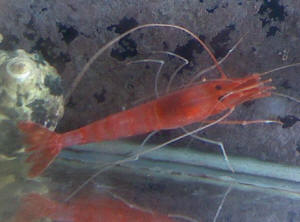 |
| Any ideas on what type of sand sifting shrimp
this is? 8/12/08<... A Penaeid of some species... see
your search tool, images re. Bob Fenner, who misses
Lynn...> |
|
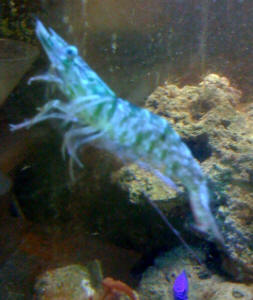
|
| Shrimp ID help please - 06/29/08Hello
WWM crew. Attached is a picture of a shrimp that I would like some
help verifying its ID, please. This shrimp was found by a friend of
mine while diving in Panama City, FL (northern Gulf of Mexico). She
found it when she picked up a long spine sea urchin to show to a
student (she is a dive instructor). She came to me and to a biology
teacher for help in identification. The biology teacher thought it
to possibly be in the Periclimenes family or possibly the
Gnathophyllum family. <The latter... though at first I too
thought it was a Palaemonid... faulty memory... more so all the
time> I did a lot of Google work and also searched your site but
found little info. Based on a few difficult to see photos, I
believe it is Gnathophyllum elegans. This seems supported (at least
down to the Gnathophyllum family) by the fact that it was found on
the bottom of an urchin, and Julian Sprung's book
"Invertebrates: A Quick Reference Guide" reports that
Gnathophyllum may feed on the feet of urchins and sea stars.
<Mmm, nah! Must> The best photos I could find with the full
scientific name came from not what I would consider highly reliable
sources and most of them were not written in English, but they were
the closest matches I could find and did indicate the scientific
name of Gnathophyllum elegans. Any help you could give towards a
definite ID would be greatly appreciated. Also, what are your
opinions as to their aquarium suitability (given that it would
almost certainly require a species only biotype). I realize their
natural diet would be difficult to replicate and not desirable to
replicate in my opinion. Mr. Sprung recommends feeding finely
chopped meaty foods and even flake foods; <No... like most of
its family, this animal feeds on the tube feet of certain
echinoderms found in its range. An interesting remark... it is
recorded as a facultative cleaner, removing parasites from fishes,
when young> however, I think he is somewhat overly optimistic on
some animals' aquarium suitability. Thanks for all your help
(past, present and future!). Sincerely, Rob Watson <Am almost
sure this is Gnathophyllum panamense... found from the lower Sea of
Cortez in Mexico's Baja to Ecuador... Bob Fenner> |
|
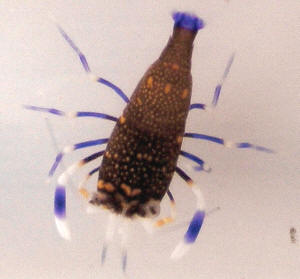
|
SW Aquarium ID if possible 3/20/08 Hi WWM
Crew! Recently I've housed all my fish in QT due to Ich and
Brooklynellosis outbreaks. But my question has to do with thousands
of tiny things, almost unseen to the naked eye, in my main tank. At
first we though they were part of the Ich parasite's life
cycle, but upon closer inspection they appear to be baby fish.
<Mmm, nope> One of my yellowtail blue damsels has had a
bulging belly lately but we never saw her lay any eggs and
she's quite small (not even an inch in length). I've tried
searching the web but no luck. So I've attached a photo...are
these guys baby damsels or something else? Thanks for your time!
Tracy
<Something else... larval... shrimp! Neat-o! BobF> |
|
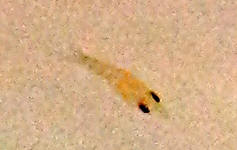
|
|
Shrimp ID: Possibly Tozeuma - 3/7/08 Dear
Sirs: <Heeee! In this case, Madam, but please call me Lynn
instead!> Please check on the photograph I have in my
multiply:
http://pinneng.multiply.com/photos/album/15/Manado-Bunaken-Lembeh_Part_1#10
<Nice photo of a neat little shrimp! It took me a minute to
realize that it wasn't so much hair-like as it was
transparent mid body, with white along the top/dorsal and
underneath/ventral areas. Many commensal shrimps are like this,
as far as being close to transparent and rather difficult to see.
This sort of cryptic patterning/coloration breaks up the
appearance of the body shape, making it more difficult for
potential predators to recognize, or perceive them, as prey.>
I took this in Bunaken, North Sulawesi. <Beautiful area!>
It was as thin as a hair. With the length of about 1cm. Can you
please identify the shrimp? <I believe it's a shrimp in
the family Hippolytidae, genus Tozeuma, similar to this:
http://www.poppe-images.com/images/image_info.php?picid=946703
http://www.poppe-images.com/images/image_info.php?picid=946704
> Thanks! <You're very welcome, and thank you for
sharing such a nice photo! Take care, -Lynn>
|
|
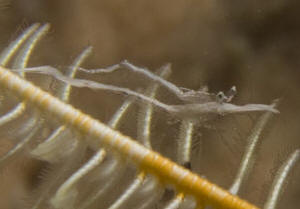
|
Unidentified Shrimp... Perhaps a Ghost Shrimp 9/11/07 This
is Paul again. <Hola Paul, Mich aqui> I just wanted to send
you a picture of one of the shrimp in my tank. I have another
just like it. I am currently living in Brazil (Curitiba) and this
was a shrimp offered at the aquarium store (www.aquabetta.com.br)
I thought you guys might like to look at it. <Always nice.>
Maybe you haven't seen one like it before. If you have, can
you tell me what its name is? <I could be wrong, but it looks
like a pretty glass or ghost shrimp to me. Ghost shrimp are often
used as feeders More here:
http://images.google.com/imgres?imgurl=
http://www.fishlore.com/Pictures/Profiles/ghost_shrimp_2.jpg&imgrefurl=
http://www.fishlore.com/profile-ghostshrimp.htm&h=150&w=250&sz=6&hl=en&start=16&um=1&tbnid=mn4UJo7N5z_
kqM:&tbnh=67&tbnw=111&prev=/images%3Fq%3Dglass%2Bshrimp%
26svnum%3D10%26um%3D1%26hl%3Den%26safe%3Doff%26client%3Dsafari%26rls%3Den%26sa%3DG
> Thanks a lot. <De nada! Mich>
Re: Unidentified Shrimp... A Ghost Shrimp 9/12/07
Buenos Dias Paul, Mich here again.> I thought ghost shrimp
were freshwater. <Can be fresh... can also be salt... I have
collected myself from saltwater in the Belmar NJ inlet.> They
have been living in my saltwater tank for 7 months now. <Yes,
there are several species. Many can tolerate great ranges in
salinity. RMF is in agreement with this ID.> Thank again.
<Welcome!>
Paul
|
|
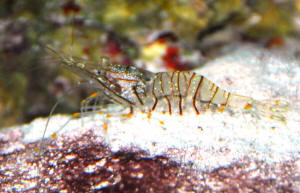
|
Shrimp?, Yes is a shrimp, type ? 3/14/07 Any
idea what this guy is? Good? Bad? <Hmm, really a guess at best,
almost looks edible, like a king prawn, but I don't know much
about their behavior. Perhaps a type of Saron shrimp, maybe a male,
but he's not as bristly as I would expect, but Sarons are
predacious and would explain the missing tank mates. RMF your
thoughts?> <<Does look like a female Saron sp. of some
sort... have Debelius' work out on Crustaceans... looks most
closely like S. rectirostris to me. RMF>> Thanks!
<Welcome! Mich> <p.s. Check today's FAQ's as RMF
may comment there.> Jess Note: forwarded message attached. Hi
Penny, Jess again. So in storming my tank I uncovered a strange
looking thing, a shrimp of some sort maybe? I don't know. I
looked up on the net mantis shrimp ( maybe the culprit for my
deaths ) but he doesn't look like one? <Not a mantis
shrimp.> Mantis all look to be beautifully colored and the eyes
are what are also noticeable. This thing is dull colored and has 2
appendages like things that flank either side of him from his mouth
that go back. I have picked him up and handled him and he's not
nasty like I heard mantis are. Any idea what the lil bugger is?
Good? Bad? If you need other pics let me know and I'll do my
best. Thanks
Jess |
|
Re: Shrimp?, Yes is a shrimp, type Saron ? rectirostris
3/14/07 So after receiving your reply as what you thought it
may be I looked them up on the net but the ones I have found
don't look like this guy I have in my tank. <Hmm, did you
see Bob's comment on the daily FAQ's? >And I do
generally send these to the original querior/s. RMF<
<<Does look like a female Saron sp. of some sort... have
Debelius' work out on Crustaceans... looks most closely like
S. rectirostris to me. RMF>> Some good picture of Saron
rectirostris can be seen here: http://forum.marinedepot.com/Topic61881-11-1.aspx >
His legs are a purplish/blue the underside of his body is a
reddish color and the topside is a cream with some brownish
spots. He's not to brightly colored. He also has two things
that he holds along side of him but they seem to act as a sort of
antenna for him. They are also a bit bristly as well as the front
2 ( feet? ) I have watched him closely to monitor his
behavior....he does not seem to bother any of the other tank
mates at all. He just crawls around the bottom sifting through
the top layer of sand. I have not seen him eat anything outside
of whatever invisible things he finds in the sand....but he does
not touch the Mysis or brine shrimp or anything else that is
being fed. So whatever he is he does not seem to be causing any
harm. He is about an inch and a half long he's actually
pretty big ( or so I think ). Maybe this will help more in
identifying him. I will also get some more pictures of him and
send them along. He's very easy to handle. He lets me scoop
him out of the sand and will stay perched in my hand. Thanks
again <Welcome! Check out the link and see what you think.
Hope that helps. Mich> Jess
|
|
/Saron%20PIX/near%20saron%20shreemp.jpg)
|
| Critter ID: Shrimp 3/1/07 Hello, <Hi
there, Mich here.> I have been an avid reader of your website
for nearly 2 years now but have never emailed before as I have
always found the answers I needed. <Very good to hear!> Today
however I noticed a little critter sitting in my mushrooms! It
definitely has legs which you cannot see in the photo. <Looks
like a shrimp to me. I believe it is an Anemone Shrimp
(Periclimenes spp.) though the banding pattern also reminds me of a
pistol shrimp (Alpheus spp.) though these prefer the sand bed.>
It is about half an inch long and it looks like its eyes are on
white stalks (don't quote me on that though!) I have attached a
pic so if any of you wonderful people can identify what it is and
whether it is safe or should I get rid of it? <It should be reef
safe.> Sorry if the picture is not good enough but my camera
wouldn't focus any closer. Many thanks in advance and keep up
the superb work you all do. <We'll try! -Mich>
<<Outstanding. RMF>> |
|
/Pontonides/vcrit%20id%20wwm.jpg)
|
Snails Preying on Baby Shrimp? ...Unlikely -
02/09/2007 Hello all, <Hi there Armani! Mich here.> I recently
moved some Chaetomorpha from my main tank into my refugium
(hang-on-back type). Much to my surprise, it contained many microscopic
cleaner shrimp (Lysmata amboinensis) larvae. <Mmm, more likely you
are seeing tiny Mysis shrimp.> I've been feeding the larvae
marine snow, phytoplankton, and a few Spirulina flakes. <Mmm,
careful not to overfeed, these can be very polluting, and not essential
for these shrimp.> Last night I placed some Nassarius snails into
the refugium and in the morning, the amount of shrimp has been greatly
reduced. <Likely unrelated.> I know this species, like many
snails, are scavengers, but wouldn't the shrimp be able to swim
away from them? <Yes.> Is it possible they've eating my
babies?! <Unlikely.> Great website by the way, keep up the great
work. <Thanks, will try.> regards, <And to you. -Mich>
Armani
Some Sort of Shrimp ID? Hey guys, I have a 30 gallon tank
with about 20lbs LR and 18 lbs Lava base rock. <<Eee.. lava? Must
mention its relative propensity to leach minerals.>> I was doing
my routine check and saw what look like tiny shrimp. These are about 1
cm long apiece and are about 30-40 of them free swimming in my tank.
<<Ok.>> I have had these before. <<Did it
itch?>> They appear for only one day and then disappear. I have a
skunk cleaner shrimp but have never seen it brood eggs, and these
shrimp are there every two to three weeks for one night. They have what
looks like an embryo sack that they get there food off until they grow
larger. <<Interesting. If you see a yolk sac (what's the
white of an egg called?) then I would indeed surmise that you're
likely looking at babies. Who is spawning them, I couldn't tell
you, but they're not a bad thing.>> Other than that they are
tiny and clear to white with black eyes. Can you help me ID these?
Thanks- Aaron <<No, I'm afraid I can't. Photo evidence
might be helpful, but if we *are* talking embryonic shrimps, that alone
may not be enough. Marina>>
What kind of shrimp? I recently discovered that I have lots
and lots of what seem to be clear looking shrimp (I think) approx.
2-4mm in length in my tank. What are they and should I get rid of them?
I only happened to figure out I had them because I found them (and kept
finding them) in my worm trap. (I don't like bristle worms). Thanks
for your help. ***Mysis shrimp, and they are harmless. A common dweller
in reef tanks. They generally stay hidden during the day in a system
with fish. In a system without fish they are out at all hours. Jim***
How can I identify my shrimp larvae? Dear Sirs, << And
Maam's, although "Hey Blundell" will work for today.
>> Can you help me find a good site to view Lysmata larvae
pictures or images? << Nope, but I know who can. >> Last
night I had a large spawn of unidentified parents. I currently have 2
banded coral shrimps, 2 Lysmata debelius and 4 scarlet skunk shrimps in
a 90 gal tank. I must have over 200 infants with a size of 3mm to 4mm.
Around 100 are already in a separate tank. My biggest concern is that
the offspring might be mantis shrimp. I currently have three in my
aquarium. << That would be great, they are worth more money.
>> Thanks in advance.
<<
You need the Lysmata expert to help you here. Email Andy Rhyne at
arhyne@fit.edu and tell him Blundell gave you his email address. He is
the king of raising shrimp. >> David Erard Caracas, Venezuela
<< Blundell, jealous he isn't in Venezuela. >>
An Aussie shrimp by any other name is still... 7/6/04 (common
names vs. scientific names) G'day Anthony, <cheers mate> Mate
I was just kicking back reading my MARINE ATLAS vol 1, when I came
across the picture of a BANDED BOXING SHRIMP, it looks exactly like the
CORAL BANDED SHRIMP, the atlas does not have a picture of the
C.B.Shrimp. Are these two the same species or what? <yes... there
are many common names for many animals (tens of common names for some)
given by regional people around the world. This is one reason why is it
best for us to learn the scientific names of our species to use - at
least with the common names if not instead of them. Thus, when someone
says Stenopus hispidus, you'll know exactly which shrimp they are
talking about :)> Thanks Mate Chris (Oz) P.S. YOUR X.X.X.X. IS
GETTING WARM (OZ BEER) <after the rough month I just had/am having,
my friend... nothing would suit me finer then zipping off to Australia
and sipping (occasionally gulping) tasty beer with new friends. Thanks
kindly for the offer/reminder. Kindly, Anthony>
|

|
| Those Sexy Little Shrimp! A friend of mine
got 2 of these shrimp at his LFS under the dubious name "Sexy
Shrimp". They walk up and down the tentacles of the anemone in
the picture. Can't find them on your website or in CMA book.
What are they? Good, bad, depends? Thanks! :-)Tracy Creek <Well,
Tracy, it looks to me like you're the owner of some sexy Thor
amboinensis. They are perfectly harmless, and stay pretty small,
too! They are almost always found in association with anemones, and
can eat a variety of small foods, such as Mysis and other finely
chopped seafoods. Pretty cool little shrimp, IMO! Hope this helps!
Regards, Scott > |
Lysmata sp? Hello Bob; I have a quick question I hope can
help with. I have recently begun raising a species of shrimp I am
tentatively labeling as Lysmata kukenthali, as my resources are a bit
limiting. I was curious if you could recommend an expert in the family
Hippolytidae to better identify the species. Cheers, Matt Wittenrich
<Mmm, the only person off the top of my head to ask in turn is
Helmut Debelius. Send your query and pix along and I'll cc him
re... and if he is unable to assist we'll try elsewhere. Bob
Fenner> Peppermint Shrimp by any other names 4/4/04 Hey there
staff!!! You're the best, I appreciate all of your advice in the
past and the advice that's to come in the future. <were looking
forward to in in kind> We all know that there is always some
confusion with the true peppermint shrimp......whether it be from the
suppliers not ID'ing the specimens properly.....or the LFS's
purchasing what they THINK are peppermint shrimp... and so on and so
forth. I know there are mainly two species of shrimp which get tied up
in a knot with each other, one being the true peppermint.....and the
other being the false. <OK... I believe this to be true for your
part of the world (varies elsewhere by region/merchant)> My question
is this... I have both species, Lysmata wurdemanni and L. rathbunae>
may I ask which is the "true" peppermint....as they are way
too comfortably interchanged!!!!! <L. wurdemanni is the true
Peppermint shrimp, essentially> and would it be the true of the
false peppermints...........that bother worms and the likes??? Or am I
wrong, as in both may do harm depending on the individual specimen???
<the entire genus Lysmata is categorically risky in reef aquaria and
all have been known to nip corals and other desirable reef inverts at
times> I appreciate your time.........thank you again. <best
regards, Anthony>
What's in a name? A lot :) 2/14/04 Hi I was just
researching the scarlet lady shrimp and I was wondering if you could
tell me if the scarlet lady also has the same habits as the white strip
cleaner shrimp, (such as cleaning a fish). I gave also been wondering
if you could keep several scarlet lady shrimp in the same tank with
several white spotted cleaner shrimp. The tank size is a 120 gal deep.
and I am going to have coral so I would like to know if the scarlet
lady would be alright with coral. Thanks a million Jonathan!!!!!!!
<I really am not sure what species of shrimp you are referring to my
friend. I'm guessing you mean Lysmata debelius. Common names vary
in different regions of the country and world... its important to use
scientific names whenever possible. In this case, there are several
different genera known as "cleaner shrimp" although your use
of the word "scarlet" tells me these are probably Lysmata
species. Use the above name I have given you to do a keyword search on
our website and others to gather information. best regards,
Anthony>
Mystery Critter--Are These Bad Ones? (12/21/03) hi i am 14
and have my own marine aquarium but i have one problem, i have tiny
little prawn like creatures in it, I believe that they are manta shrimp
there is about 30 of them around 1cm long they are frustrating me and
don't no if they are good or bad for my aquarium, and if they will
nip the fins of my fish and kill them (that's what I have heard). I
want to get rid of them any suggestions, can u please help
????????????? <Welcome to the marine aquarist community. I wish I
had one when I was your age 30 years ago. A couple of questions about
your tank: How big? How long has it been set up? Does it have live
rock? From where? What else have you put in? With the little
information I have to go one, I doubt that what you have are Mantis
Shrimp. Getting one or two in a tank happens sometimes, but not thirty.
By the size, I'd guess they are large copepods. These are not bad
things to have and are not dangerous. Many fish love to eat them.
Search WWM and elsewhere for descriptions & photos. Steve Allen>
please reply ASAP, thank you <You're welcome; hope this
helps!>
Mystery Critter--Are These Bad Ones? Ian's go. (12/21/03)
hi i am 14 and have my own marine aquarium but i have one problem, i
have tiny little prawn like creatures in it, I believe that they are
manta shrimp there is about 30 of them around 1cm long <Do you have
any pictures?. I have never heard of Live rock containing more than 30
mantis shrimp...I am not saying it can't happen. but we should both
know what kind of creatures these are. send me pics if at all
possible> they are frustrating me and don't no if they are good
or bad for my aquarium, and if they will nip the fins of my fish and
kill them (that's what I have heard).<If they are truly mantis
shrimp...and they are only around 1cm in length...they are not capable
of doing any harm to any of your fish. when they get bigger its a
different story though :) > I want to get rid of them any
suggestions, can u please help ?????????????<good luck, IanB>
please reply ASAP
thank you
|
|

